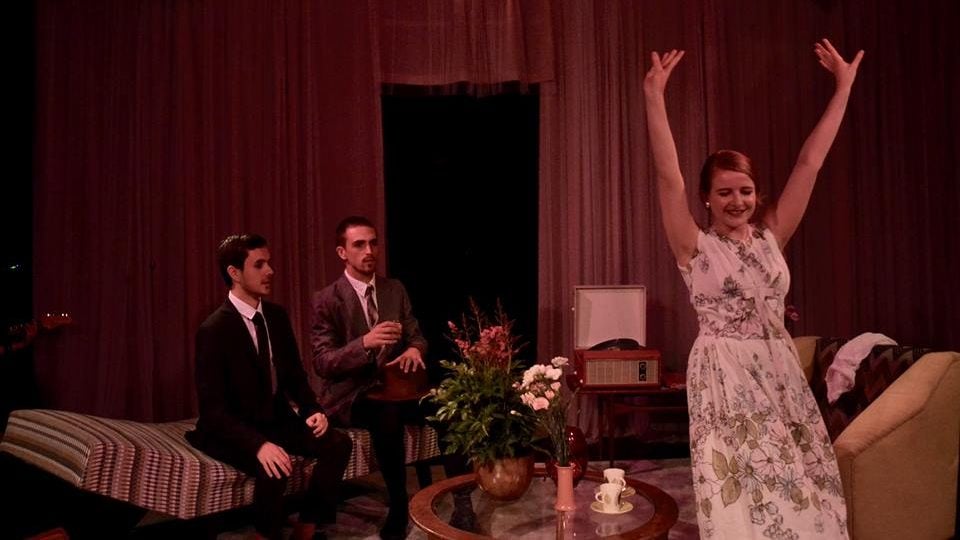Henrik Ibsen’s A Doll’s House was a play phenomenally ahead of its time when it first opened in 1879. It tells the story of Nora (Ceidra Murphy), housewife and most treasured possession of her husband, Torvald (James Akka). Whilst on the surface, the Helmer household is the perfect picture of domestic bliss, the façade is tainted when it is revealed that Nora borrowed money behind her husband’s back, and committed forgery in the process. As one crack appears, the entire artifice breaks down, and Nora is forced to ask serious questions about her seemingly flawless life.
Sour Peach Productions brings Ibsen’s play to the 1960s. The resulting glorified domesticity is characteristic of the post-war period. The sleek and somewhat kitch aesthetic connotes pop culture classics such as Mad Men and The Stepford Wives. This production should certainly be commended for its aesthetic attention to detail. From its beautiful trailer (which apparently was made using film sent especially to Berlin for developing), to the costume (Connie Furneaux), I, and indeed other audience members from what I could gather, found this production very visually pleasing.
The characters navigate the cramped space with an amplified self-consciousness, both heightening the tension between characters and illustrating the performative nature of domesticity. The claustrophobia owes a lot to the thrust staging – as an audience member on the front row I couldn’t help but feel exposed, even voyeuristic, as the narrative unravelled in front of me. Consequently, Nora’s experience of entrapment within the walls of her home is ever-present because, for the audience, it is visceral.
With her playfulness, secrecy and tendency to tantrum, Ceidra Murphy brings to Nora a childishness that is alarmingly believable. Highlighting Nora’s infantile disposition works particularly well, as the character begins to reflect on the parallels between her paternal relationship and her marital one – to her father, and subsequently her husband, she is a “doll” to be decorated and brandished as an accessory. I was impressed by Murphy’s sophistication in the role and hope to see more of her on the Oxford stage. Townsend came into her own with real gravitas as Christine, Nora’s perceptive school friend. The most compelling scene came from Christine’s reconnection with former flame Krogstad (Flinn Andreae), in which weighty silences were beautifully balanced with truly heart-wrenching moments of emotional vulnerability.
Whilst it is true that Sour Peach Productions delivered the tense atmosphere wholly appropriate for Ibsen’s narrative, I ended up feeling dissatisfied by the adaptation of the script. The play is normally around two and a half hours long, and this version was around an hour and half. I can sympathise with a desire to cut such a long script for the sake of a student production. Equally, I can see that changes needed to be made for the adjustment in period. However, I felt that the loss of a significant amount of the original script meant that the pace of the narrative was stunted. By the end, Nora’s decision to leave the family home seemed to come out of nowhere. I have always experienced Nora’s resolution as a dramatic eruption of the subconscious – the result of a slow, but constant, build-up of resentment and repression. In my view, Sour Peach Productions’ script did not succeed in communicating the incredible power of Nora’s eventual realisation or, perhaps more significantly, did not signpost the route to such a realisation convincingly.
Whilst Ibsen’s landmark script has not entirely been done justice in this case, this production of A Doll’s House has some emotionally compelling performances. Most significantly, Sour Peach Productions should be congratulated for their visually stunning production – it is rare that other student plays put so much thought into creating such a cohesive aesthetic experience.



